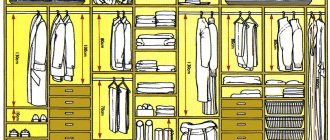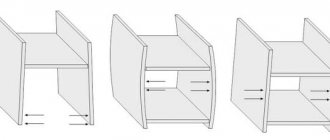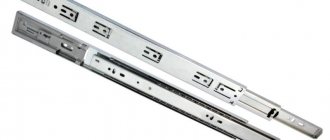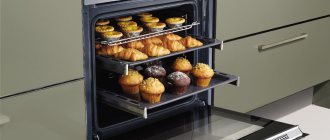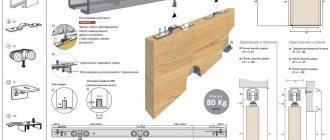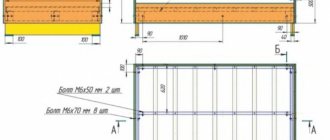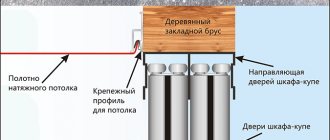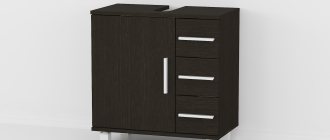Installing a cabinet is not an easy task, especially when you don’t know how and where to install some of the components for this piece of furniture. Auxiliary parts can be, for example, ball guides for drawers. Not everyone knows how to install them, but in the meantime, without them it will not be possible to create a full-fledged place for storing clothes and any other accessories. In this material we will talk in detail about what parts the ball guide mechanism consists of, and how to install these components in the place intended for them.
Ball guides for drawers: how to install
Ball guide design: highlights
So, in order to understand the operating principle of the components we install, it is necessary to turn to their most simplified version - two-section non-separable guides. These parts consist of two rails, which:
- vary in size;
- have the shape of the letter “P”;
- are located one inside the other.
The operation of this element of the system, which is responsible for drawing out the drawers, is carried out due to the mutual movement of tracks made of steel relative to each other, which, in fact, make up the part that interests us. They are also called telescopic because of the way they fold.
Installing ball guides for drawers does not take much time
Between these tracks, as a rule, in the upper and lower parts, there are small balls. They are similar to the same balls that are usually placed in a bearing.
The element responsible for maintaining the structure as a single whole is the outer rail segment. It plays the role of a limiter, preventing the device from moving the drawer further and damaging the weight of the piece of furniture.
Instructions for replacing guides
To replace broken roller runners, you need to use a screwdriver to unscrew all the fasteners and remove the strips. Ball-type ones are more difficult to remove: pull out the drawer as much as possible, press the latch down with your fingers, and smoothly pull the structure toward you. Dismantle the planks from the side walls of the furniture, removing all the screws.
Installing new guides for dresser drawers is not difficult: they all have a similar design, and the holes for the fasteners match. There is no need to mark. The strips are applied to the holes remaining from the screws and screwed. Check the correct position and, if necessary, adjust it by loosening the fasteners.
Having learned how to properly mount the guides, you can independently repair failed elements or install new ones on your own furniture. When choosing the optimal option, you should take into account the planned load: if it is large, you should give preference to ball structures.
Did you manage to solve your problem using the recommendations from the article?
Yes!
51.52%
No. More answers required. I'll ask in the comments now.
27.27%
Partially. There are still questions. I'll write in the comments now.
21.21%
Voted: 33
Existing types of ball guides
The system we are considering today, which comes as a component for home furniture, can take various forms. So, they will vary due to the original purpose of this motor system, and the set of functions with which it was originally endowed. In the table below, let's study what ball guides can be and by what criteria they are distinguished.
There are many types of ball guides
Table 1. Types of ball guides
| Criterion | Description of species |
| Possibility to disassemble the device | According to this criterion we can distinguish:
|
| Number of "steps" | Based on this parameter, we can divide existing types of guides of the type we are interested in into:
|
| Construction type | According to the item you are looking for, ball guides can be distinguished:
|
| Device installation method | Installation of the parts we are interested in can be carried out in two ways:
|
A box with such guides moves almost silently and can withstand considerable weight
The final cost of mechanisms that cannot be disassembled after installation without losing functionality will be much less than the same value for dismountable mechanisms. The fact is that the latter are produced using sophisticated technology, and are ultimately equipped with specially reinforced balls, which allow the device to be disassembled and reassembled several times without damage or fear of losing small structural elements.
The balls inside the device are made of steel. They move along the internal space of the metal profile, allowing you to easily pull out drawers made of absolutely any material and of any size from a closet, chest of drawers, beds and other pieces of furniture.
These guides are suitable for installation on drawers made of almost any material.
The final cost of these propulsion systems will be influenced by any of the parameters listed above in the table, not just the possibility of disassembly. So, the more pure stages and the number of levels with which the desired system is equipped, the more expensive it will become. This is due, of course, to the difficulties that the manufacturer had to go through when creating the device we are interested in.
Prices for the model range of roller guides
Roller guides
The role of ball guides in furniture production
Despite the fact that the principle of operation of telescopic devices is used to create many products in various fields of scientific and practical human activity, they most often continue to be used in the production of cabinet furniture of various types.
Ball guides are needed to equip furniture with them, which then becomes much more functional, and in addition:
- allows drawers to slide out silently;
- increases the permissible load, which has a direct impact on the box, extending its service life.
Scheme for installing ball guides in a drawer and the box underneath it
So, as an example, we can cite wardrobes, inside of which multiple drawers are installed, saving free space and generally increasing the usability of this piece of furniture. Usually such drawers are filled with clothes and accessories, as they say, to capacity. And yet, thanks to ball guides, they work silently and accurately.
By installing ball-type guides into your piece of furniture, you will increase the service life of the furnishings equipped with them, as well as increase the convenience and efficiency of using the furniture.
Specific installation calculations will depend on the parameters of the box and fasteners selected for it
Types of telescopic guides
To understand how to carefully pull out a drawer in a kitchen or other unit, you need to understand the classification of telescopic guides.
In modern furniture sets, various rail guide systems are installed for ease of use.
There are several types:
- roller and ball, determined by the type of moving mechanism. Rollers have a shorter service life, withstand much less load and become noisy over time. They cost less than ball systems;
- full or partial extension, which depends on the degree of extension.
Important! If a partial extension system needs to be repaired, the back of the dresser will be obscured from view. Such guides have a budget price.
Typically, only the most comfortable models are found on the modern market.
Metaboxes have been developed based on roller systems. Tandem boxes are considered the most expensive option. The last criterion: location of installation. You can purchase products that are installed on the side or bottom of the drawer, the so-called hidden installation.
They usually cost more, but they are very convenient and practical.
Ball guides for drawers: selection of parts
The set of components we are interested in consists of:
- left telescopic skid;
- right telescopic skid.
Each of the mentioned runners is also divided into two component segments.
Please note: do not assume that ball bearings can only be installed on commercially manufactured furniture. No, in fact, they can be installed on furniture made by yourself, but you will first need to find out its parameters and purchase suitable parts according to them. The fact is that the guides differ from each other in many different parameters, among which thickness is of particular importance.
Each component parameter must be selected by carefully measuring the piece of furniture being assembled
The depth of the box on which the installation will be carried out must be equal to the length of the part we select, however, we must take into account that between the back wall of the piece of furniture being equipped and the back wall of the box on which the guides are placed, it is necessary to leave a minimum gap of 1 centimeter
Also, when selecting guides, it is necessary to take into account the thickness:
- the retractable mechanism itself;
- the outer walls of our box.
In addition, do not forget about adding a technological gap that compensates for the inaccuracies you made when measuring. Using this gap will subsequently provide the drawers with completely free movement. Most often, the value of this technological parameter is approximately a millimeter.
Adjustment of drawers using this type of guides is carried out in two planes
The width of the drawer is calculated by subtracting the following double values:
- thickness of the outer part of the walls;
- the thickness of the mechanism itself;
- the size of the gap left.
The same parameter as the length of the box will be limited by the free space at our disposal. However, it is much easier to calculate it, because all you need to do is reduce the free space by the size of the next gap.
In order to carry out the measurements we need, we will first have to install the drawer in the cabinet box according to all the rules, and then we will be able to adjust it, make the markings correctly, and subsequently properly hang the guides.
Telescopic guides for drawers are modern fittings that allow you to effortlessly open even massive structures. Would you like to learn in detail about the installation of telescopic guides and the correct calculation for their installation? Read the special article.
Video - Ball guides. Installation
Marking and adjustment
Before attaching the drawer guides, you need to prepare the following tools:
- building level;
- drill with a set of wood drills;
- screwdriver;
- self-tapping screws;
- screwdrivers (phillips, flat);
- roulette;
- square;
- pencil.
To install ball guides, drawers need to be marked in 2 directions: horizontally and vertically. Fasteners installed in the holes at these points will allow you to adjust the position of the runners.
Procedure:
- The side of the box is measured with a ruler, determining the middle. They do this from both ends. The points are connected by drawing a line with a pencil.
- Transfer the marking point to the side of the body.
- Using a building level, extend the mark along the entire plane of the sidewall.
How to install ball guides on drawers with your own hands
So, we have come to the moment for which, in fact, you were looking for this article. It involves learning how to independently install ball guides on drawers for a cabinet or other piece of furniture. So let's get started.
Drawer on ball guides
Step No. 1 – make markings for fittings
So, first of all, you need to make markings for the fittings being installed. It is done using a pencil and a ruler, since we need to mark the axis passing strictly through the central part of the box.
First of all, we need to draw an axis under the guide
After this stage is completed, we move on to the next one.
Step No. 2 – Attach the component runner to the marked side of the drawers
So, we have drawn the axis along which the parts will be installed. Now you need to place a guide rail on it so that the front edge of this part is flush with the façade of the furniture segment being equipped. However, you need to carefully ensure that the part does not bulge forward, since in this situation it is quite possible that a gap will appear, which we do not need at all.
Pay attention to the runner. The regulating holes cut on it will help us place it correctly. They are small and oblong.
The required adjustment holes are needed in order to correctly secure the runner relative to the box
Using the discovered holes, we align our runner strictly along the marked axis. This is easy to do: just line up all the holes with a line so that it clearly runs through their center.
Then we insert a self-tapping screw into the hole located horizontally on our part. Now we can move the runner back and forth without changing the position of its segment.
Adjustment hole responsible for the direction of movement up and down on the back of the drawer
We secure the rear segment of our runner through the gap responsible for the movement of the box along the vertical axes. This will be necessary in order to subsequently be able to adjust the height of the box by following the next few simple steps.
- Using a screwdriver or screwdriver, remove the self-tapping screw from the front hole, which is responsible for the horizontal movement of the box.
- We will re-screw the same self-tapping screw, however, into the front hole, which is responsible for the movement of the box along the vertical axis.
Duplicate adjustment hole for the “up and down” direction, for the front segment of the cabinet part being equipped
Then we will get that the part will subsequently be attached to the box through two control holes located both in the front and in the back of the box, which are responsible for its movement along the “up and down” axis.
Step No. 3 - installing the guide directly to the side of the box
Now, in order for our device to work and the drawers to slide out, it is necessary to attach the second part of our guide system to the inside of the cabinet box, inside which the drawer is then installed.
The mounting hole, inside of which a self-tapping screw is placed, is of the most common type, round
Prices for cordless screwdrivers
Cordless screwdriver
Only here you need to take into account one important point: unlike the segment of the guide system that attaches to the side of our drawer, the part that goes into the box has much more adjustable holes. And in addition to the gaps through which the system can move along the axes of interest to us “up and down” and “forward and backward,” they also have other grooves of the horizontal and vertical type, into which screws also need to be screwed.
Mounting hole and adjustment grooves, the presence of which must be taken into account when installing this part of the guides
Attach the guide and adjust it, thus inserting screws as in the previous step into only two holes so that the box fits inside the correct box. Once you are sure that everything is installed and adjusted as intended, remove the boxes again and screw the screws into all the holes of the box parts.


